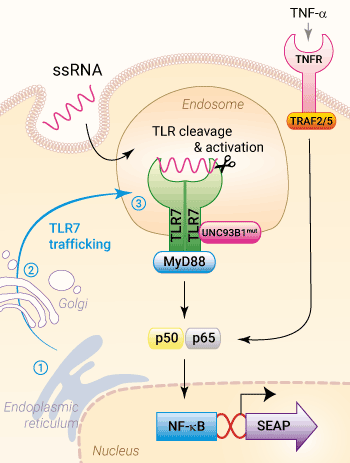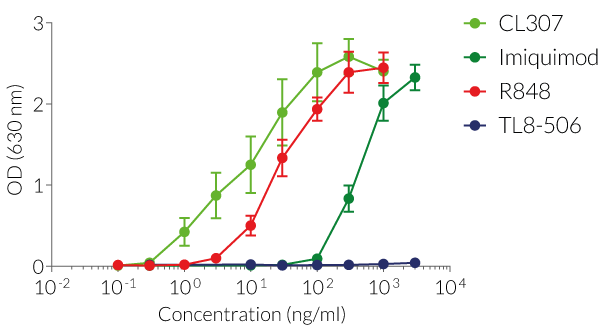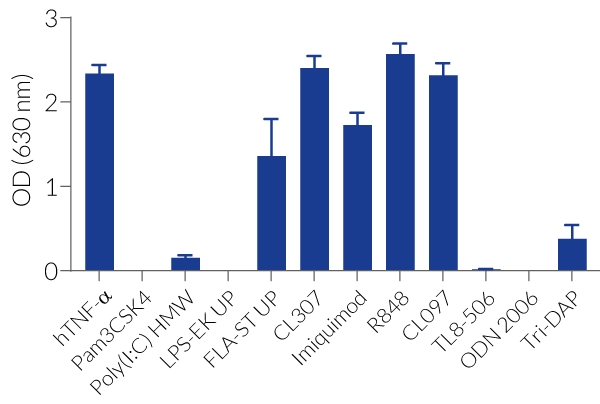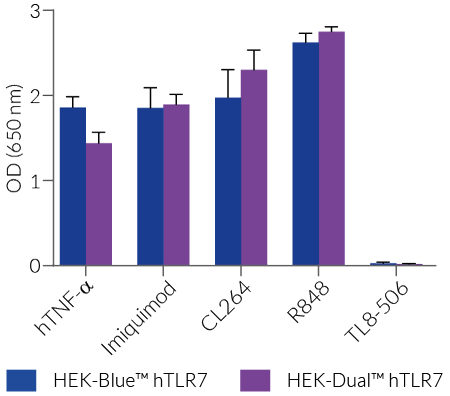Human TLR7 Reporter HEK293 Cells (NF-κB)
| Product | Unit size | Cat. code | Docs. | Qty. | Price | |
|---|---|---|---|---|---|---|
|
HEK-Blue™ hTLR7 Cells Human TLR7 expressing HEK293 reporter cells (NF-κB pathway) |
Show product |
3-7 x 10e6 cells |
hkb-htlr7v2
|
|
||
|
HEK-Blue™ hTLR7 vial Additional cell vial |
Show product |
3-7 x 10e6 cells |
hkb-htlr7v2-av
|
Notification: Reference #hkb-htlr7v2-av can only be ordered together with reference #hkb-htlr7v2.
NF-κB–SEAP reporter HEK293 cells expressing human TLR7

Trafficking & signaling in HEK-Blue™ hTLR7 cells
(click to enlarge and see legend)
HEK-Blue™ hTLR7 cells were engineered from the HEK-Blue™ Null1-v cell line to study the Toll-like receptor 7 (TLR7)-dependent NF-κB pathway. This important pattern recognition receptor (PRR) recognizes viral single-stranded RNA (ssRNA) structures and subsequently triggers NF-κB and IRF immune responses [1].
Description
HEK-Blue™ hTLR7 cells express the human TLR7 gene and a mutated (mut) version of the chaperone protein UNC93B1. In addition, they feature an NF-κB/AP-1-inducible SEAP reporter gene. SEAP (secreted embryonic alkaline phosphatase) levels produced upon TLR7 stimulation can be readily determined by performing the assay in HEK-Blue™ Detection, a cell culture medium that allows for real-time detection of SEAP. Alternatively, SEAP activity may be monitored using QUANTI-Blue™, a SEAP detection reagent.
Due to the co-expression of hTLR7 and UNC93B1mut, HEK-Blue™ hTLR7 cells strongly and stably respond to TLR7-specific ligands. They do not respond to TLR8-specific ligands (see figures).
As TLR7 activates both the NF-κB and IRF signaling pathways, InvivoGen also offers HEK-Dual™ hTLR7 cells; a cell line expressing a dual reporter system comprising an NF-κB-inducible SEAP and an IRF-inducible Lucia luciferase (learn more here).
Of note, HEK293 cells express endogenous levels of various PRRs, including TLR3 and TLR5. Therefore, they might respond to their cognate ligands (see figures).
Key Features
- Verified co-expression of human (h)TLR7 and UNC93B1mut
- Strong and stable response to TLR7-specific ligands
- Distinct monitoring of NF-κB by assessing the SEAP activities
Applications
- Defining the distinct role of TLR7 in the NF-κB-dependent pathway
- Screening for TLR7-specific agonists or inhibitors in comparison with their parental cell line HEK-Blue™ Null1-v
Note: A new clone is provided with an improved reporter/background signal ratio. The cat code has been changed accordingly (hkb-htlr7v2). Its parental cell line is HEK-Blue™ Null1-v.
References:
1. Georg P. & Sander L.E., 2019. Innate sensors that regulate vaccine responses. Curr. Op. Immunol. 59:31.
Back to the topSpecifications
Antibiotic resistance: Hygromycin B, Zeocin®
Growth medium: DMEM, 4.5 g/l glucose, 2 mM L-glutamine, 10% (v/v) fetal bovine serum, 100 U/ml penicillin, 100 μg/ml streptomycin, 100 μg/ml Normocin™
Quality Control:
- Stable expression of human (h)TLR7 and UNC93B1mut has been verified by RT-qPCR and functional assays.
- The activation of NF-κB/AP1 upon TLR7 stimulation has been verified using functional assays.
- The stability for 20 passages, following thawing, has been verified.
- These cells are guaranteed mycoplasma-free.
Note: HEK293 cells express endogenous levels of TLR3, TLR5, and NOD1.
The appropriate parental cell line for HEK-Blue™ hTLR7 cells is HEK-Blue™ Null1-v.
Contents
- 1 vial containing 3-7 x 106 cells
- 1 ml of Hygromycin B Gold (100 mg/ml)
- 1 ml of Zeocin® (100 mg/ml)
- 1 ml of Normocin™ (50 mg/ml)
- 1 pouch of HEK-Blue™ Detection (cell culture medium for real-time detection of SEAP)
![]() Shipped on dry ice (Europe, USA, Canada, and some areas in Asia)
Shipped on dry ice (Europe, USA, Canada, and some areas in Asia)
Details
Toll-Like Receptor 7
In humans, four Toll-Like Receptor (TLR) family members TLR3, TLR7, TLR8, and TLR9, mainly found in the endosome, are specialized in sensing viral-derived components. TLR7 and TLR8 recognize single-stranded (ss)RNA structures, such as viral ssRNA, miRNA, and various synthetic agonists [1]. Despite their similarities in PAMP (pathogen-associated molecular pattern) recognition, structure, and signaling partners, they highly differ in expression profiles and signaling responses, with TLR7 being more involved in the antiviral immune response and TLR8 mastering the production of proinflammatory cytokines [2]. TLR7 is mainly found in plasmacytoid dendritic cells (pDCs) and B cells, whereas TLR8 is highly expressed in monocytes, monocyte-derived DCs (mDCs), and macrophages [3].
TLR7 trafficking and signaling
Upon viral infection, the chaperone protein UNC93B1 interacts with TLR7, thereby facilitating its trafficking from the endoplasmic reticulum via the Golgi into the endosomes [4]. Subsequently, TLR7 undergoes proteolytic cleavage and dimerization [1,3]. Once activated, it recruits the adaptor protein MyD88 to trigger IRF, AP-1, and NF-kB responses via TRAF6 (TNF receptor-associated factor 6) [1,3]. Depending on the stimulus and cell type, TLR7-mediated signaling induces IFN-α and IFN-regulated cytokines or T helper 17 (Th17) polarizing cytokines, such as interleukin (IL)-1β and IL-23 [5].
TLR7 therapeutic targeting
The involvement of nucleic acid-sensing mechanisms in the immune response against infections and other diseases makes them interesting targets for drug design [5]. TLR7 agonists are currently been tested as vaccine adjuvants and immunomodulatory therapeutics. They are extensively studied in the context of viral infection (e.g. SARS-CoV-2, Influenza, HIV), autoimmune (e.g. asthma, Lupus), and autoinflammatory diseases (e.g. cancer) [1-5]. Understanding the fundamental differences between these two related receptors could potentially be harnessed to discover novel drugs and improve vaccine efficacy/safety [5].
References:
1. Martínez-Espinoza I & Guerrero-Plata A. 2022. The Relevance of TLR8 in Viral Infections. Pathogens. 11(2):134.
2. Salvi V, et al., 2021. SARS-CoV-2-associated ssRNAs activate inflammation and immunity via TLR7/8. JCI Insight.;6(18):e150542.
3. Georg P. & Sander L.E., 2019. Innate sensors that regulate vaccine responses. Curr. Op. Immunol. 59:31.
4. Majer, O., et al. 2019. UNC93B1 recruits syntenin-1 to dampen TLR7 signalling and prevent autoimmunity. Nature 575, 366–370.
5. de Marcken M, et al., 2019. TLR7 and TLR8 activate distinct pathways in monocytes during RNA virus infection. Sci Signal.;12(605):eaaw1347.










